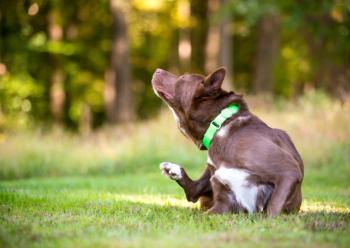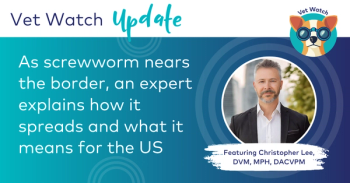
Update: Diagnosis and control of mite infestations in dogs and cats (Proceedings)
How to diagnose and control sarcoptic mange, demodicosis, Cheyletiellosis, Otodectic mange, and more.
• Sarcoptic mange : Sarcoptes scabei var. canis - "Scabies"
• Notoedres cati -"Face mange"
o Hosts and Geographic distribution
• Sarcoptes scabei - All domestic animals and man (rare in cats); Worldwide
• Notoedres cati - Cats; rarely on dogs; Worldwide – in U.S. primarily southeastern states
o Diagnosis
• History! Rapid onset of pruritus and distribution of lesions
• Skin scrapings
• Scrape new, apparently unaffected skin as well as erythematous areas.
• Mount in mineral oil and look for mites with characteristic dorsal spines.
• May find mites in only 50% of cases.
• Do multiple superficial skin scrapings - mites difficult to find look for eggs or parts of mites.
• Best diagnostic aid is response to therapy. "Therapeutic trial"
o Scabies treatment
• Selamectin (Revolution; Pfizer Animal Health) FDA approved: 6 – 12 mg/kg spot-on; day 0, & 30; clinical resolution can be quickened using the alternate application regimen –Day 0, 14, & 30. In infested kennels or refractory cases an additional dose on day 60 may be needed.
• Fipronil spot-on and spray (0 & 30 days) control label only
• While not approved, the treatments listed below have been used.
• Ivermectin oral or Sub Q at 200 to 400 μg/kg every 14 days for 3 to 4 treatments is commonly used. Do not use in Collies and other susceptible breeds.
• MDR1 deletion mutation associated with ivermectin sensitivity. Ivermectin causes neurologic toxicity in some, but not all Collies, at doses (approx 100μg/kg) that are >8x higher than what occurs in Heartgard (6-12μg/kg). Neurologic manifestations of ivermectin toxicosis in susceptible dogs include: hypersalivation, ataxia, blindness, coma, respiratory compromise, and death. Over half of tested Collies (54.6%) have the mutated gene. The mutated gene has also turned up in several other breeds. Neff MW. et al. Breed distribution and history of canine mdr1-1Δ, a pharmacogenetic mutation that marks the emergence of breeds from the collie lineage. Proc. Nat. Acad. Sci. 101(32)11725-11730, 2004. Before using in susceptible breeds a test is available at Washington State
• Milbemycin oxime orally 2 mg/kg (0, 7, 14, & 21 days or 0, 14 and 28 days)
• Imidacloprid/moxidectin (Advantage Multi) 2 doses 4 weeks apart.
o Notoedres (no approved treatments)
• Selamectin (Revolution; Pfizer Animal Health) 6mg/kg spot-on; day 0, & 30. Studies indicate that a single dose is 100%
• Lime-sulfur dip 2.5% weekly for 6 to 8 weeks
• Ivermectin 300 μg/kg (125 μg/lb) orally or subcutaneous injection.
• Demodicosis - Demodectic Mange, Follicular Mange, Red Mange Demodex canis
o Predisposition
• Newborn pups do not harbor mites. Transmission occurs during the first 72 hours of life while the pup is nursing. Pups taken by caesarian section do not harbor mites.
• Demodectic mange is not considered to be a contagious disease (vs. Sarcoptic mange)
• Predisposition to overpopulation of mites and development of clinical disease is not completely clear, but Juvenile On-Set Generalized Demodectic Mange is an inherited disease and research suggests it may be an autosomal recessive mode of inheritance.
o Disease Forms
• Localized Demodectic Mange
• Juvenile On-Set Generalized Demodectic Mange
• Adult On-Set Generalized Demodectic Mange (also Demodectic Pododermatitis)
o Diagnosis
• Deep skin scrapings (Pinch up an area, and scrape deep enough to get some blood)
• Since the mites are normal inhabitants of the skin the demonstration of a single mite does not confirm a diagnosis of demodicosis. Typically you will find large numbers of adults or excessive immature forms
• Rarely mites may be difficult to find. Re-scrape if you suspect Demodex but find no mites!
o Therapy: Note the treatment for localized and generalized forms are completely different. Therefore, understanding the difference between the two forms and proper diagnosis is critical.
• Localized
• Most dogs with Localized Demodicosis have no immunologic defect, prognosis is excellent. If lesions are asymptomatic and owner understands lesions should resolve spontaneously, treatment may not be necessary. Lesions will resolve in 3-8 weeks.
• Generalized
• Prognosis for generalized demodicosis always guarded and may be poor. Successful treatment depends on severity of pyoderma, immune status of dog, and communication with owner. Discuss pathogenesis and genetics of disease with owner.
• If a dog is less than 1 year of age, may self-cure in 50% of cases. Once you decide to treat, evaluate the dog and the owner. Treatment for Generalized Demodicosis may be prolonged, expensive and no guarantee of success.
• Amitraz (MitabanR) dip is the primary treatment. Various treatment protocols exist with dipping schedules weekly to every two weeks and concentrations varying from 0.025 to 0.125%. However, the FDA approved usage is 0.025% every two weeks.
• Treatment should continue 4 weeks after scrapings show no mites. Treatments may take several months. Longhaired dogs should be clipped prior to dipping. Once mites eliminated; follow-up exams every 6 to 12 months.
• Alternative therapies: If mite numbers do not decrease or lesions have not cleared after several weeks, alternative therapies should be considered.
o Increasing concentration or frequency of Amitraz treatments.
o Milbemycin oxime (0.5 – 2.0mg/kg) orally once daily for 60 to 90 days
o Ivermectin (200 to 600μg/kg) orally once daily for 60 to 90 days; Do not use in Collies and other susceptible breeds.
o metaflumizone + amitraz at the proposed minimum dose rate (20mg/kg of each of metaflumizone and amitraz, 0.133ml/kg)
• imidacloprid 10%+moxidectin 2.5% at labeled rate at monthly intervals.
• Feline Demodicosis: Demodex cati - (Demodex folliculorum var. cati); Feline demodectic mange mite
• Demodex gatoi - a short stubby form. Also an unnamed species similar to D. criceti in hamsters
o Diagnosis
• Clinical signs & Scrape and demonstrate mites
o Treatment
• 1.5 to 2.5% Lime sulfur bath every 7-10 days usually curative in 4 to 6 weeks
• Cheyletiellosis - "Walking dandruff"
o Cheyletiella yasquri - (dogs)
o C. blakei - (cats)
o C. parasitivorax - (rabbit & cats)
o Diagnosis
• History! - Recent group contacts (dog & cat shows, etc.) or recently acquired from kennel, etc.
• Dermatologic lesions on people living in household
• Demonstrate mites: "Clear tape preparation" - Part hairs on cat, use tape to pick up debris, mites, etc. Tape acts as coverslip. Use mineral oil as mounting medium. Butcher paper method (Groom vigorously) – brush mites onto brown paper. KOH digest - comb vigorously place hair and debris in 10% KOH over night or heat gently for 15 minutes, centrifuge & examine sediment. Superficial skin scraping. No. 10 scalpel blade dipped in mineral oil. Fecal flotation (especially cats)
o Treatment — No approved treatments*
• Dogs:
• *Selamectin 6-12mg/kg topically on days 0,15 & 30
• *Ivermectin administered at 300 μg/kg SQ or orally; treat at 14 day intervals for 3 to 6 weeks (has been used in both dogs and cats; do not use in Collies and other sensitive breeds without testing).
• *Fipronil spray; reports of successful treatment
• Cats:
• *Selamectin 6-12mg/kg days 0,15 & 30
• *Ivermectin administered at 300 (g/kg SQ or orally; treat at 14 day intervals for 3 to 6 weeks.
• Rabbits
• Selamectin 6-12mg/kg days 0,15 & 30
• Otodectic mange; Otoacariasis; "Ear Mites"
o Otodectes cynotis - Ear mite
• Diagnosis
• Physical exam –" Otoscope
• Ears swabs - microscopy
• Treatment
• Clean ears! - Several different commercial formulations for cleaning ears
• ACAREXX™ is administered topically in the ear canal at an ivermectin concentration of 0.01%. One dose of 0.5 mL is applied in each ear. Repeat treatment one time if necessary, in cats and kittens four (4) weeks of age and older.
• MilbeMite™ OTIC is administered topically in the ear canal. Each plastic tube contains 0.25 mL of a 0.1% solution of milbemycin oxime. One dose is applied in each ear. Repeat treatment one time if necessary, in cats and kittens four (4) weeks of age and older.
• Selamectin 6-12 mg/kg twice at 30 day intervals. Also used in rabbits..
• Imidacloprid/moxidectin (Advantage multi)
• Blot C, Kodjo A, Reynaud MC, Bourdoiseau G: Efficacy of selamectin administered topically in the treatment of feline otoacariosis. Vet Parasitol 112(3):241–247, 2003.
• Fourie LJ, Kok DJ, Heine J: Evaluation of the efficacy of an imidacloprid 10%/moxidectin 1% spot-on against Otodectes cynotis in cats. Parasitol Res 90(suppl 3):S112–S113, 2003
• Krieger K, Heine J, Dumont P, Hellmann K: Efficacy and safety of imidacloprid 10% plus moxidectin 2.5% spot-on in the treatment of Sarcoptic mange and otoacariosis in dogs: Results of a European field study. Parasitol Res 97(suppl 1):S81–S88, 2005.
• Shanks DJ, McTier TL, Rowan TG, et al: The efficacy of selamectin in the treatment of naturally acquired aural infestations of Otodectes cynotis on dogs and cats. Vet Parasitol 91(3–4):283–290, 2000.
• "Chiggers, Harvest Mites or Red Bugs"
o Trombicula sp. or Eutrombicula sp. mites
• Feed on humans, as well as a wide variety of snakes, lizards, turtles, birds, dogs, rarely cats and small mammals. (only larvae parasitic). Chigger mites are small mites (1/20 to 1/64 inch long), orange, yellow or light red (usually bright red), and have hairy bodies. After hatching, chigger larvae climb up onto vegetation from which they can attach themselves to a passing host. Chiggers are usually encountered in late spring and summer in woodlots, pastures, roadside ditches or other areas with tall grasses and weeds.
• Pathology
• Chigger larvae do not burrow into the skin, nor suck blood. They pierce the skin and inject a salivary secretion containing digestive enzymes that break down skin cells that are sucked up. After a larva is fully fed (3-4 days) it drops from the host, leaving a red welt. Intense pruritus and erythemia at site of welts usually develops three to six hours after exposure. Red dome-shaped papules 10 – 16hours post exposure. Pruritus can persist for 20 – 30+ hours
• Diagnosis
• Remove and identify mites
• Treatment
• Anti-inflammatory doses of oral antihistamines and corticosteroids
• Mites may or may not still be present
• Various acaracides will kill mites. Fipronil (dogs or cats) or Permethrin (dogs only)
• The best defense against chiggers is to avoid or repel them.
• Permethrin has repellent like activity with spray or spot-on formulations offering some benefit to dogs, no effective or safe repellents for cats!!!
References
Curtis CF. Current trends in the treatment of Sarcoptes, Cheyletiella and Otodectes mite infestations in dogs and cats. Vet Dermatol. 2004 Apr; 15(2):108-14.
Foley, R.H. 1991. Notoedric mange epizootic in an island cat population. Feline Practice 19:8-10.
Fourie LJ, Heine J, Horak IG. The efficacy of an imidacloprid/moxidectin combination against naturally acquired Sarcoptes scabiei infestations on dogs. Aust Vet J. 84(1-2):17-21, 2006.
Itoh N, Muraoka N, Aoki M, Itagaki T. Treatment of Notoedres cati infestation in cats with selamectin. Vet Rec. 2004 Mar 27; 154(13):409.
Shanks DJ, McTier TL, Behan S, Pengo G, Genchi C, Bowman DD, Holbert MS, Smith DG, Jernigan AD, Rowan TG. The efficacy of selamectin in the treatment of naturally acquired infestations of sarcoptes scabiei on dogs. Vet Parasitol. 2000 Aug 23; 91(3-4):269-81.
Six RH, Clemence RG, Thomas CA, Behan S, Boy MG, Watson P, Benchaoui HA, Clements PJ, Rowan TG, Jernigan AD. Efficacy and safety of selamectin against Sarcoptes scabiei on dogs and Otodectes cynotis on dogs and cats presented as veterinary patients. Vet Parasitol. 2000 Aug 23; 91(3-4):291-309.
Heine J, Krieger K, Dumont P, Hellmann K. Evaluation of the efficacy and safety of imidacloprid 10% plus moxidectin 2.5% spot-on in the treatment of generalized demodicosis in dogs: results of a European field study. Parasitol Res. 2005 Oct;97 Suppl 1:S89-96
Fourie LJ, Kok DJ, du Plessis A, Rugg D. Efficacy of a novel formulation of metaflumizone plus amitraz for the treatment of demodectic mange in dogs. Vet Parasitol. 2007 150(3):268-74.
Garfield, R.A. and L.M. Reedy. 1992. The use of oral milbemycin oxime (Interceptor) in the treatment of chronic generalized demodicosis. Vet Dermatol 3:231-235.
Ghubash R. Prasitic miticidal therapy. Clin Tech Small Anim Pract. 2006 Aug;21(3):135-44.
Holm BR.Efficacy of milbemycin oxime in the treatment of canine generalized demodicosis: a retrospective study of 99 dogs (1995-2000). Vet Dermatol. 2003 Aug; 14(4):189-95.
Paradis, M. and E. Laperriere. 1992. Efficacy of daily Ivermectin treatment in a dog with Amitraz-resistant generalized demodicosis. Vet Dermatol 3:85-88.
Chailleux N, Paradis M: Efficacy of selamectin in the treatment of naturally acquired cheyletiellosis in cats. Can Vet J 43:767–770, 2002.
Curtis CF. Current trends in the treatment of Sarcoptes, Cheyletiella and Otodectes mite infestations in dogs and cats. Vet Dermatol. 2004 Apr;15(2):108-14.
Ghubash R. Parasitic miticidal therapy. Clin Tech Small Anim Pract. 2006 21(3):135-44
Page N, de Jaham C, Paradis M. Observations on topical ivermectin in the treatment of otoacariosis, cheyletiellosis, and toxocariosis in cats. Can Vet J. 2000 Oct;41(10):773-6.
Paradis, M., D. Scott and A. Villeneuve. 1990. Efficacy of ivermectin against Cheyletiella blakei infestation in cats. J Am Anim Hosp Assoc 26:125-128.
Newsletter
From exam room tips to practice management insights, get trusted veterinary news delivered straight to your inbox—subscribe to dvm360.






